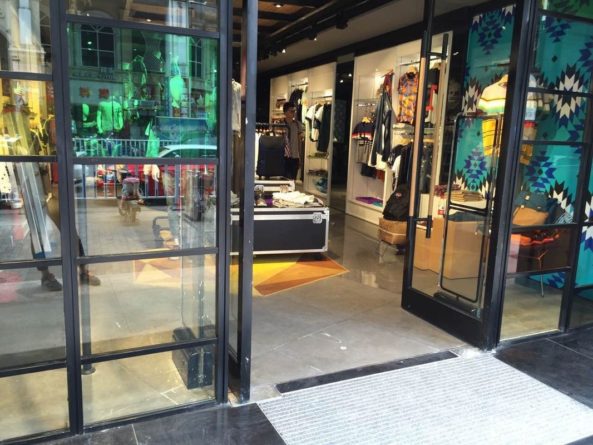Original article sourced from the ARA
Summertime trading for your surf store often means that you are dealing with a number of challenges; managing new staff, stock levels, crazy trading hours and of course security. Working in a coastal surf store every summer with the influx of summer trade, I used to see security as one of the biggest issues to manage. How do you plan and manage theft. They are valid questions I’m 100% certain that have crossed manager’s and store owners minds, which is why it’s an important thing to plan for and understand what to do incase it happens. Stores need to consider how they might reduce the risk of each and decide how best to deal with those situations that do occur to minimise the risk of injury to staff and customers and the loss or damage to merchandise.
Develop Theft Procedures
Theft in a retail context is the removal of merchandise by staff, customers, and people posing as customers or in some cases, suppliers without the consent of the owner or manager. In contrast to robbery, there is no direct engagement with staff, no weapons and no overtly threatening behaviour. The intention of thieves is to go about their activities undetected. It is this distinction that makes it so challenging for retailers to develop strategies effective enough to reduce theft to zero.
When developing procedures to follow in cases of theft it is essential that retail managers consider how staff will execute them. Clear policies that staff find easy to understand are key to successful implementation. Strategies and actions to reduce the likelihood of theft will be covered in future sections of this workbook. In this section we are focused upon policies and procedures that guide staff in what to do if theft occurs.
External Theft
Planning early allows a more effective response to theft. In the event of theft being detected as in the case of shoplifting, store teams need to know which actions to take to handle the situation properly. How to do so depends upon the business approach to the following questions:
- Is the goal to prosecute or have merchandise returned?
- Does the store have a zero tolerance policy for shoplifting?
- Will shoplifters under 18 and over 65 be prosecuted?
- Is there a minimum dollar amount that flags prosecution?
- How or will shoplifters be confronted and detained?
- What will be the response if shoplifters show remorse or offer to pay?
- Who will be responsible for calling the police?
Consistency and fairness are important in the development of shoplifting policies. It is also valuable to consider how professional thieves will perceive your approach. If your store has a policy not to prosecute, you may become more of a target, if you always prosecute, you may become less of one.
Internal Theft
It often comes as a surprise to many outside the retail world that internal theft is as big of an issue as external theft. Preventing internal theft (that done by employees) is a constant challenge for retailers.
The best way and often the most impactful way is to tackle internal theft is through improvements to recruitment and prospective employee screening. Taking the time to check references before making an offer of employment can be effective in preventing those with a history of theft from gaining employment with you.
Just as in the case of external theft it is important to consider the wider business implications of responses to internal theft whilst developing related policies and procedures:
- Is the goal to prosecute or have merchandise returned?
- Does the store have a zero tolerance policy for internal theft?
- Is there a minimum dollar amount that flags prosecution?
- How will suspected staff be confronted and detained?
- What will be the response if they show remorse or offer to pay?
- Who will be responsible for involving the police?
- Does legislation relating to equal opportunity and discrimination have a bearing on the response?
- How will internal communications be designed to provide the necessary information to staff in the case of staff resignation, sacking or prosecution as a result of theft?
It is only through consideration before the fact that retailers can respond appropriately after the fact. Imagining that theft will never happen in your store is both naïve and foolish and can send a message of being an easy target. The best way to reduce the risk of theft is to have appropriate policies and procedures that are communicated and implemented consistently.

Develop Robbery Procedures
Robbery is the act of taking or attempting to take something of value by force or threat of force. Often a weapon is used, and in contrast to theft, the act is overt and direct often involving violence or intimidation.
Whilst considerable effort and investment goes into preventing theft, retailers focus more upon what to do in the event of a robbery rather than attempting to prevent them. Whilst certain strategies can be employed to minimise risk and will be discussed later in this workbook, most retailers have the safety of their staff and customers top of mind.
In planning a robbery, the perpetrators often visit the store prior to gather key information about entry and exit points, the location of their target items be it merchandise or cash, and the likely number and positioning of sales and security staff.
For retailers planning their response to robbery, the same process should be followed. Viewing the store through a potential robber’s eyes can provide insights into their likely movements and the likely areas of risk.
Decisions need to be made as to:
- How staff and customers can be protected and safely evacuated
- When police should be called and by whom
- How staff can flag an emergency without being detected
- How staff should behave if faced with or threatened by a robber
- Whether staff should follow all requests made by robbers
- What to do in the case of injury to staff or customers
Involving police or security specialists in the development of policies and procedures related to robbery is advisable as such matters are not an everyday occurrence in retail and therefore unlikely to be an area of expertise for store owners and managers.
Develop cash security procedures
Cash is a highly prized target for both thieves and robbers for obvious reasons. Quickly transferable, unlikely to be traceable and easy to carry, it is the Holy Grail to prospective perpetrators.
The appeal of cash and the ease of transfer make it a cause of temptation for opportunistic thieves, who otherwise may not contemplate theft. It is, for these reasons that retailers need to develop comprehensive policies and procedures around cash security.
Again several questions need to be asked to ensure cash procedures are developed in alignment with business needs:
- Where does cash need to be available?
- In which quantities?
- How is cash transferred in and out of the store and in which quantities?
- Is a safe in use, how is it accessed and by whom?
- What are the store opening and closing times?
- How do staff access and leave the store?
- Do POS systems allow voids, no sales, refunds etc?
- Are different currencies, travellers’ cheques, personal cheques, credit cards, EFT and cash accepted?
- Are vouchers, gift cards and other forms of non-cash transactions accepted?
In asking these questions retailers can isolate the areas of biggest risk where internal and external theft can occur in their specific business and develop policies and procedures that contribute to risk minimisation.








